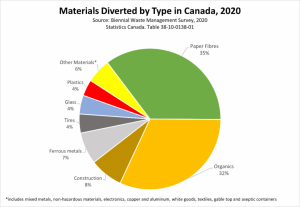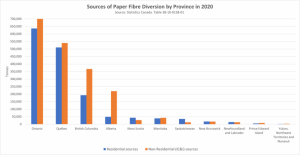On November 15, 2022, Statistics Canada released the results of its biennial Waste Management Survey, containing waste diversion data for 2020, broken down by material type and diversion source (residential and non-residential).
The new data shows that Canadian households and businesses diverted 9,903,027 tonnes of waste in 2020, and of the total amount diverted, 3,502,683 tonnes were paper fibres (which includes newsprint, cardboard and boxboard, and mixed paper), representing 35% of the total amount diverted in 2020.
While paper diversion represents the majority of materials diverted from landfill in Canada, paper diversion has been trending slightly downward year over year since 2014, which could be partly attributed to the continued decline of newsprint materials due to the shift from print to digital.

The next leading category of materials diverted in Canada for 2020 was organics with 32% of the total share of diversion.

Digging deeper into the paper diversion data, of the 3.5 million total tonnes diverted in Canada in 2020, about 44% was diverted through residential sources (ie. Blue Box residential municipal recycling programs), while the remaining 56% was diverted through non-residential sources (ie. Industrial Commercial and Institutional (IC&I) collection).
Below is a breakdown of the sources of paper diversion by province, with the two most populous provinces, Ontario and Quebec, diverting the most paper fibre from both residential and non-residential (IC&I) sources.

Of the other 33% of diverted materials, Statistics Canada reported that “diverting plastic waste to avoid its disposal has become a challenge because of the many types of hard-to-recycle plastics being produced for consumption and entering the waste stream.” Of the 9.9 million total tonnes of waste materials diverted in Canada in 2020, 368,343 tonnes of plastics, or about 3.7%, were diverted.
The Government of Canada has been working to address plastic waste as part of its Zero Plastic Waste Agenda. PPEC continues to monitor government and industry activities related to plastics and we recently wrote about how Canada’s new ban on single-use plastics may impact the paper packaging industry. And while the plastics industry is looking to create a circular economy for its materials through various initiatives, including the Canada Plastics Pact, the paper packaging industry has long held a large-scale circular economy for its materials.
Using recycled materials is an inherent part of our members’ operations. For decades PPEC members have used recycled paper materials as its primary feedstock in making the three major paper packaging grades in Canada (containerboard, boxboard, and kraft paper). They use old corrugated cardboard and other paper-based materials, collected from the backs of factories, supermarkets, office buildings, and from residential recycling programs to make new paper-based packaging.
PPEC’s membership represents several different components of our industry’s recycling supply chain, not just as providers of recyclable paper-based packaging, but also as processors of collected paper materials, and as mills who are recycling and reusing the collected materials, which allows them to be remade into new paper packaging products again and again, keeping valuable raw material out of landfill.
